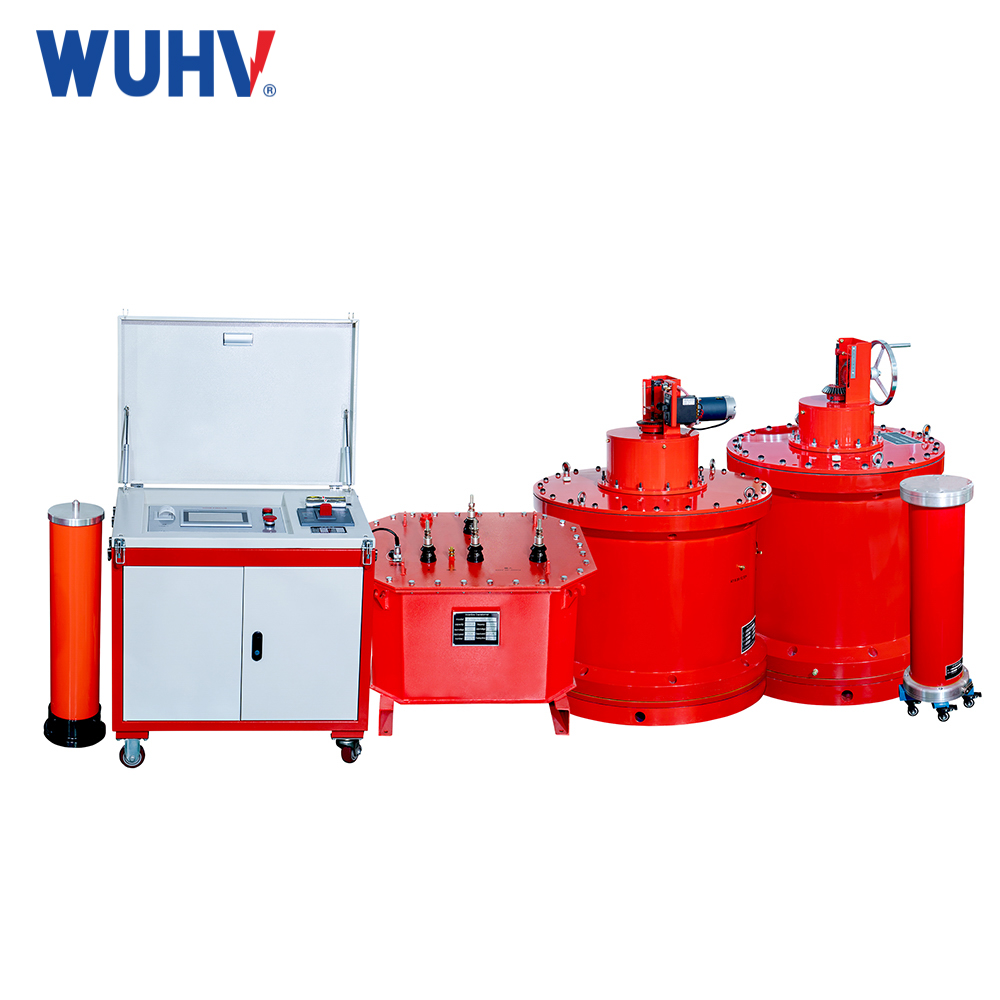Sistema de prueba resonante de la serie AC de frecuencia variable ajustable de inductancia UHV (L) is specialized, high-power AC electrical testing equipment designed primarily for testing the withstand voltage and partial discharge performance of ultra-high voltage electrical equipment like power cables, generators, transformers, Gas Insulated Switchgear (GIS), bushings, and other large-capacitance loads in HV substations and laboratories.
Its core purpose is to apply a high AC test voltage to the test object efficiently and safely, simulating operating stress, using the principle of electrical series resonance.
Key Feature: Sistema de prueba resonante de la serie AC de frecuencia variable ajustable de inductancia UHV (L) allows flexible tuning of the reactors to match the specific capacitance of different test objects, enabling resonant conditions over a wide range of capacitances using a single, relatively compact set of reactors.

Advantages:
1、High Efficiency & Low Input Power: Only circuit losses need to be supplied. Power requirements are typically only 1/5th to 1/20th of traditional 50/60Hz test transformers for the same output kVA. Enables testing on-site with standard generators.
2、Smaller, Lighter, More Portable: Significantly reduced size and weight compared to massive power frequency test transformers of equivalent kVA rating. Enables mobile labs and field testing.
3、Excellent Voltage Waveform: Generates a pure, low-distortion sinusoidal test waveform matching power frequency stress, crucial for reliable PD detection and insulation diagnostics. Avoids DC testing limitations for XLPE cables.
4、Intrinsic Safety: Flashover or breakdown of the test object causes a loss of resonance. This instantly collapses the HV circuit voltage (V_Cx drops rapidly towards zero) and limits fault current.
5、Gradual Voltage Application: Precise ramp-up/ramp-down control is inherent.
Automatic Tuning: Modern systems automate frequency sweep and resonance finding.
6、Minimal Test Object Damage: The instant voltage collapse on breakdown limits energy discharge into the fault.
7、Versatility (Thanks to Adjustable L): Taps allow optimal resonance for a wide range of test object capacitances with one set of reactors. Ideal for labs testing diverse equipment types/sizes.
8、Superior for XLPE Cables: Considered the standard method for testing modern extruded dielectric cables due to waveform suitability and effectiveness in revealing water treeing issues.
Disadvantages:
1、Higher Initial Cost: More complex electronics and precise reactors lead to higher purchase cost than simpler DC or low-power VLF (0.1Hz) sets (though cheaper than equivalent kVA transformer sets).
2、Complexity: Involves sensitive electronics, control systems, and precise reactor tuning. Requires trained personnel.
3、Frequency Sensitivity: Test voltage magnitude depends critically on maintaining exact resonance. Drift in L or Cx (e.g., temperature) requires retuning or compensation. Load shifts during PD events can distort the waveform or voltage reading.
4、Tuning Time: Though automated, the initial tuning sweep can take minutes, especially for high-Q circuits. Fixed-frequency systems are faster if matched perfectly to a known Cx.
5、Limited to Capacitive Loads: Requires a predominantly capacitive test object. Primarily resistive or inductive loads are inefficient or impractical.
PD Calibration Challenges: Precise PD measurement requires careful calibration due to the resonance tank's high Q and the reactive components involved.
6、Harmonic Sensitivity: Poor VF source waveform or non-linearities can excite harmonic resonances, distorting the output waveform.
Key Application Scenarios:
1、Factory Acceptance Testing (FAT): Final proof testing of new HV equipment (cables, transformers, GIS, reactors, bushings).
2、Site Acceptance Testing (SAT): Verification after installation at substations or along transmission lines.
3、HV Power Cable Testing:
Commissioning tests (AC withstand & PD) for MV and HV transmission cables (land & submarine).
After-laying tests.
Diagnostic testing and routine maintenance of cable systems.
4、GIS Testing: Commissioning and maintenance tests, including integrated circuits and PD detection.
5、Rotating Machine Testing (Generators & Motors): AC withstand testing of stator windings.
6、Transformer & Reactor Testing: AC withstand voltage testing of windings, bushings, tap changers.
7、Research & Development Labs: Investigating insulation materials and HV component designs under AC stress.
8、Utility Maintenance Programs: Proactive condition assessment of critical HV assets.



















